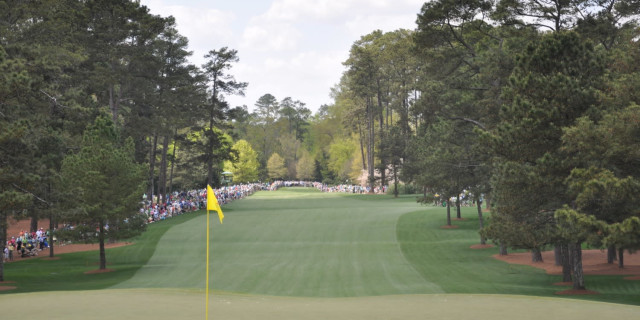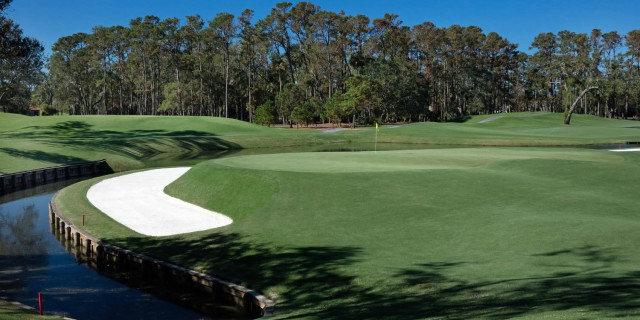
Hole by Hole Guide to Augusta National
Host of the Masters Tournament since 1934, Augusta National is the most recognisible of golf courses, viewers have grown up watching it each year for generations, learning its challenges, remembering the shots and moments that have made champions across decades.
We take a closer look at each of the 18 holes, pointing out key areas that could prove defining this week. And we all have our favourites.
1st: Tea Olive – Par 4, 445 yards
From the tee, the right fairway bunker limits space with the drive while the approach plays straight uphill to a green that slopes from front to back. Finish above the flag and you may struggle to keep your ball on the green.
2nd: Pink Dogwood – Par 5, 575 yards
An early birdie chance. Plays steeply downhill and doglegs to the left. While the drive requires a draw, the second requires a slight fade to a green that runs from left to right. Louis Oosthuizen made albatross here in 2012. This is the longest hole on the course but, because it plays downhill, is easily reachable in two.
3rd: Flowering Peach – Par 4, 350 yards
Many players will try to get their drives as close to this green as possible, eliminating the four fairway bunkers, leaving a tricky pitch up a huge false front. You may be better off being further back with a less delicate shot. This hole has hardly changed since 1933.
4th: Flowering Crabapple – Par 3, 240 yards
Any player in the field will take four pars here for the week. A raised green with steep slopes on either side make it a tiny target. With the tee sheltered in a group of trees it can be very difficult to gauge the wind.
5th: Magnolia – Par 4, 495 yards
Another dogleg left, requiring a big carry over the bunker located right at the turn. Players who can’t carry the ball 300 yards will face with a long iron into a green sloping from front to back. A brute of a hole.
6th: Juniper – Par 3, 180 yards
The second of the par threes plays sharply downhill. The green slopes to the right.

7th: Pampas – Par 4, 450 yards
This hole has been changed more than any other with significant length added. The drive is hit through a tight corridor of trees before an approach to a green protected by five bunkers. The putting surface sits well above the fairway, making it one of the hardest to find.
8th: Yellow Jasmine – Par 5, 570 yards
A dogleg right with the second shot playing uphill to a narrow green. The second shot tis blind. With no bunkers around the green it is the run-off areas and mounds that cause problems
9th: Carolina Cherry – Par 4, 495 yards
Another hole that plays uphill to the green but, with the fairway sloping down, it makes the approach particularly difficult. Hitting off a downhill lie to a green way above which slopes severely back to front requires perfect club selection or the ball will not hold the putting surface. Fail to hit the correct plateau and your ball could come all the way back down and off the green.
10th: Camelia – Par 4, 495 yards
The huge bunker in the middle of the fairway is now obsolete but the hole doesn’t yield many birdies. The approach plays uphill. Miss the green to the right and a high number could be on the cards.
11th: White Dogwood – Par 4, 505 yards
The start of Amen Corner. A straight tee shot or slight fade is required through the corridor of trees before an approach sloping steeply downhill and everything kicking left towards the water. Expect to see lots of bail- outs to the right. If any players hits it close to the hole they have pulled it.
12th: Golden Bell – Par 3, 155 yards
One of the most famous par threes in the world. Long is not good, short is worse because of the water. A slight fade over the front bunker to the heart of the green is the perfect shot. The wind plays havoc - it can swirl and double in speed within seconds because of the high pines surrounding the green.
13th: Azalea – Par 5, 510 yards
One of the best risk and reward holes in the world. A high draw is required. A hanging lie is almost guaranteed for the second shot which must also carry the water. Short and it’s wet, long faces a pitch back down the slope to a glass-like green with the water lurking.
14th: Chinese Fir – Par 4, 440 yards
This hole has reaped some valuable birdies over the years with Danny Willett, Sergio Garcia and Patrick Reed all making threes in the final round on their way to winning. This is the only hole on the course with no bunkers or water but it’s the green and the sharp incline which makes it tricky. A false front means the approach must carry to the back plateau but it might not hold as the green slopes severely left-to-right.
15th: Firethron – Par 5, 530 yards
Sergio Garcia ran up a 13 here as defending champion after putting five balls in the water. The drive must be down the right to open up a shot at the green in two but it must also avoid trees on that side of the fairway. A shallow green calls for a high approach while those choosing to lay up must judge the spin perfectly or they could see their ball come right back down the bank and into the water.
16th: Redbud – Par 3, 170 yards
Shane Lowry made a hole-in-one here in 2016. Find the right part of the green with the tee shot and it will funnel down to where the pin is cut on the final day. However, a slight push and the ball will stay on top of the ridge, leaving a lightning quick putt down the hill. Long leaves one of the toughest pitches on the course. Unless you are Tiger Woods and it’s 2005. The front right pin position is the toughest.
17th: Nandina – Par 4, 440 yards
One of the easier tee shots on the course leaves a short or medium iron to the green. However, it’s the putting surface that causes problems. Set like an upturned saucer, the approach has to be pinpoint and also must have the loft required to carry the front bunker and hold the surface. In the famous closing stretch at Augusta, this hole regularly plays as the toughest.
18th: Holly – Par 4, 465 yards
The tee shot calls for a gentle fade. The tee sits in a tunnel of trees with only the left fairway bunker visible as the hole turns sharply uphill and to the right. Hit a drive too straight and it’s in the sand, fade it too much and it’s in the trees. The pin position at the back is the toughest while the front left pin for the final day gives players the chance to fly it slightly long and allow it to funnel back.

Be part of the action with a selection of unique golf tournament experiences, from playing in a pro-am with the stars to watching the action at golf’s most illustrious events. Whether it’s the Masters or The Open, The Ryder Cup or WM Phoenix Open, build your own bespoke package with the experts at Golfbreaks.com.
Tags: the masters PGA Tour Masters









